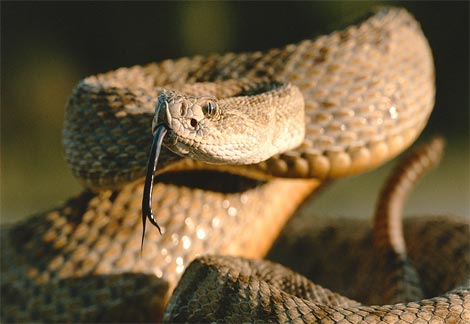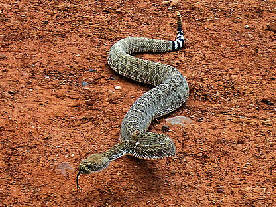Rattlesnake
|
Rattlesnakes come in different varieties and there are numerous sub species and colour variations. However, one characteristic that they do have in common is jointed rattles on their tail. Rattlesnakes are named for the rattle found at the tip of their tails that is used as a warning device when threatened. Each time a Rattlesnake sheds its skin, a new rattle segment is added. Newborn rattlesnakes do not have functional rattles. It is not until after they have shed their skin for the first time that they gain an additional bead. The new bead beats against the first bead, known as the 'button', to create the rattling sound. Adult snakes may lose their rattles on occasion, however, more appear at each moulting. If the rattle absorbs enough water in wet weather, it will not make a noise. While most of the rattlers are concentrated in the south western United States, they extend north, east and south in diminishing numbers and varieties. Every contiguous state has one or more varieties of rattlesnake. The rattlesnake is found in many different biomes ranging from along the coast at sea level, the inland prairies and desert areas to the mountains at elevations of more than 10,000 feet. Different species vary in colour and behaviour with their habitat. Three examples of different species of Rattlesnake are: Red Diamond Rattlesnake - Red diamond rattlesnakes are common in areas with little development, especially near rocky outcroppings. Southern Pacific Rattlesnake - Also called a western rattlesnake, this is the most common species and may be found near housing developments, parks and even the beach. The Southern Pacific Rattlesnake's are commonly found on prairies or sage scrub/grassland areas, especially near rocky outcroppings. South Western Speckled Rattlesnake - This species is the least seen in Southern California because it tends to be shy and avoids populated areas. Their preferred habitat is in granite rocky outcroppings.
Rattlesnakes tend to hunt at dusk. They begin to move and look for a good spot to ambush a mouse, rat, ground squirrel or rabbit. The Rattlesnakes forked tongue flicks in and out, picking up odour particles from the ground and passing them over a special smelling organ in the roof of the mouth, called the 'Jacobson’s organ'. The Rattlesnake lies in wait until its prey comes along. Even in total darkness, its prey will be visible to the snake. This is because the heat-sensitive pits on each side of the snake’s head will detect the heat from the prey and nerves transmit this information to the same area in the brain that receives optic nerve impulses. It is accurate to say the rattlesnake can see a heat image of its prey and it can strike in darkness if the prey is even slightly warmer than its background. The rattlesnake's fangs inject venom into its prey. The species and habitat of the Rattlesnake determines how potent its venom is. After the strike, the snake flicks its forked tongue in and out, picking up odour particles from the ground to help it locate the trail of the dying prey in the dark. Rattlesnakes feed on rodents and other small animals, subduing them with a venomous bite as opposed to constricting. The venom stuns or kills typical rattlesnake prey immediately. A rattlesnake will follow prey that does not quickly succumb to the venom and attempts to escape. Rattlesnakes are especially known to strike at distances up to two-thirds their body length. Rattlesnakes are prey for kingsnakes, roadrunners, pig, hawks and eagles. They have also been harvested as human food.
There are many species of rattlesnake and each can be identified by the variation of the pattern and colour of their skin. Colours can range from shades of brown, grey and black, tones of yellow, cream, rust, olive, and light pink. A rattlesnake’s skin may contain a pattern that is banded, diamond shaped, or blotched. Some species of rattlesnake have no identifying pattern at all. Rattlesnakes have a forked tongue that they flick up and down. The tongue picks microscopic airborne particles and gases from the air. When the tongue slips back into its mouth it touches a sensitive spot on the roof of their mouth called the Jacobson's organ. This organ picks up the particles collected by the tongue and sends messages to the snake’s brain identifying the scent as food, enemy, mate or other object or substance. Rattlesnakes also have external nostrils lined with olfactory cells which can pick up scent. The nostrils are mainly used for breathing. The fork of the tongue is a directional aide. It can provide information based on which side or fork in the tongue has the strongest presence of a particular odour. This information helps the rattlesnake follow its prey or find its way home. The largest Rattlesnake is the Eastern Diamondback which grows up to 8 feet (2.4 metres) and weighs 4 to 10 pounds (1.8 to 4.5 kilograms). The smallest is the Ridge-nosed Rattlesnake at 12 inches long (30.5 centimetres) and weighs 3 to 4 ounces (85 to 113 grams). Most species of Rattlesnake are 24 to 48 inches long (61 to 122 centimetres). Rattlesnakes have either a rattle or a partial rattle made of interlocking rings of keratin (the same material our fingernails are made of). When vibrated, the rattles create a hissing sound that warns off large hoofed animals or predators. Another unique characteristic is the 'pit' on each side of the head, a heat-sensitive organ for locating prey.
When a bite from a Rattlesnake occurs, the amount of venom injected cannot be gauged easily. Symptoms and swelling may occur quickly, however, in some cases hours may pass before serious effects appear. Quick medical attention is critical and treatment typically requires antivenin/antivenom to block the tissue destruction, nerve effects and blood-clotting disorders common with rattlesnake venom. Most medical experts recommend keeping the area of the bite below the level of the heart. It is important to keep a snake bite victim calm in order to avoid elevating their heart rate and accelerating the circulation of venom within the body.
|


